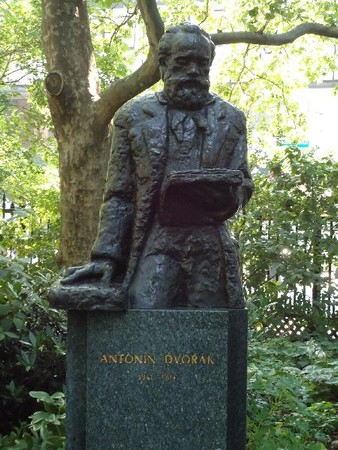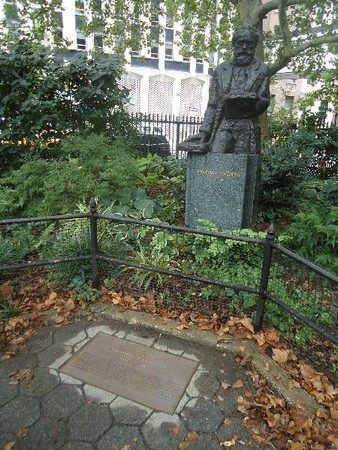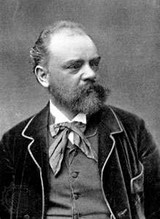Antonín Dvořák Statue
Introduction
Text-to-speech Audio
Images
Antonín Dvořák Statue in Stuyvesant Square Park

Another look at the statue along with its plaque

Antonín Dvořák (1841-1904)

Backstory and Context
Text-to-speech Audio
Antonín Leopold Dvořák was born on September 8, 1841 in the small Bohemian town of Nelahozeves along the Vltava River, about twenty-two miles north of Prague, in what is now the Czech Republic. His father was a humble butcher and innkeeper. At his father’s establishment, Dvořák was exposed to music-making from a very early age and learned to play the violin while still a boy. Fortunately for him, his parents acknowledged and fostered their son’s innate musical talent.
When Dvořák was about twelve years old, he left home and moved in with an aunt and uncle who lived in Zlonice, a small town roughly thirteen miles west of Nelahozeves. During the three years that he lived with his relatives, he studied piano and organ, and composed his earliest works (polkas). In 1857, a music teacher convinced Dvořák’s father to enroll his son in the Institute for Church Music in Prague, where Dvořák completed a two-year course. To support himself financially while attending the organ school, he played the viola and served as a private tutor.
From 1864 to 1873, Dvořák performed with the Prague National Theatre Orchestra. After leaving the orchestra, he composed Symphony No. 3, which won him a grant from the Austrian government in 1875. The award paid enormous dividends for Dvořák. It led him to develop a friendship with German composer Johannes Brahms, who not only gave Dvořák technical advice, but also introduced him to publisher Fritz Simrock. Published by Simrock’s firm, Dvořák’s Moravian Duets (1876) and Slavic Dances (1878) helped him gain international attention.
Dvořák’s fame reached its peak in the 1890s. In 1891, he was awarded an honorary doctorate of music from the University of Cambridge and began teaching at the Prague Conservatory. The following year, Dvořák moved to the United States to begin serving as director of the newly established National Conservatory of Music in New York City. While residing in the United States, he traveled the country and composed New World Symphony (1893), his most well-known work. In 1895, Dvořák returned to Bohemia to resume teaching at the Prague Conservatory. Six years later, he became its director. On May 1, 1904, Dvořák died in Prague at the age of sixty-two.
In the early 1960s, the Czechoslovak National Council of America commissioned a bronze statue of Dvořák and gifted it to the New York Philharmonic. Believed to be one of the last works of Croatian-American sculptor Ivan Mestrovic, the piece sat in obscurity for roughly three decades on a rooftop terrace of Avery Fisher Hall at the Lincoln Center for the Performing Arts. In the early 1990s, after Dvořák’s former residence on East 17th Street was demolished, the Dvořák American Heritage Association, in conjunction with the New York Philharmonic and the Stuyvesant Park Neighborhood Association, obtained the badly-neglected statue. The organizations then conserved it and created a fund for future maintenance. They also commissioned Czech-American architect Jan Hird Pokorny to design a new green granite pedestal. On September 13, 1997, the statue was dedicated in Manhattan’s Stuyvesant Square Park during a public ceremony. In attendance at the unveiling that day were hundreds of spectators and many dignitaries, including the mayor of Prague, Jan Koukal.
Sources
"Antonín Dvořák." Encyclopædia Britannica. Web. 20 January 2021 <https://www.britannica.com/biography/Antonin-Dvorak>.
"Antonin Dvorak." New York City Department of Parks and Recreation. The City of New York. Web. 20 January 2021 <https://www.nycgovparks.org/parks/stuyvesant-square/monuments/1784>.
Staines, Joe, ed. Classical Music: The Rough Guide. 3rd ed. London: Rough Guides, Ltd., 2001.
https://www.nycgovparks.org/parks/stuyvesant-square/monuments/1784
https://www.nycgovparks.org/parks/stuyvesant-square/monuments/1784
https://www.britannica.com/biography/Antonin-Dvorak
